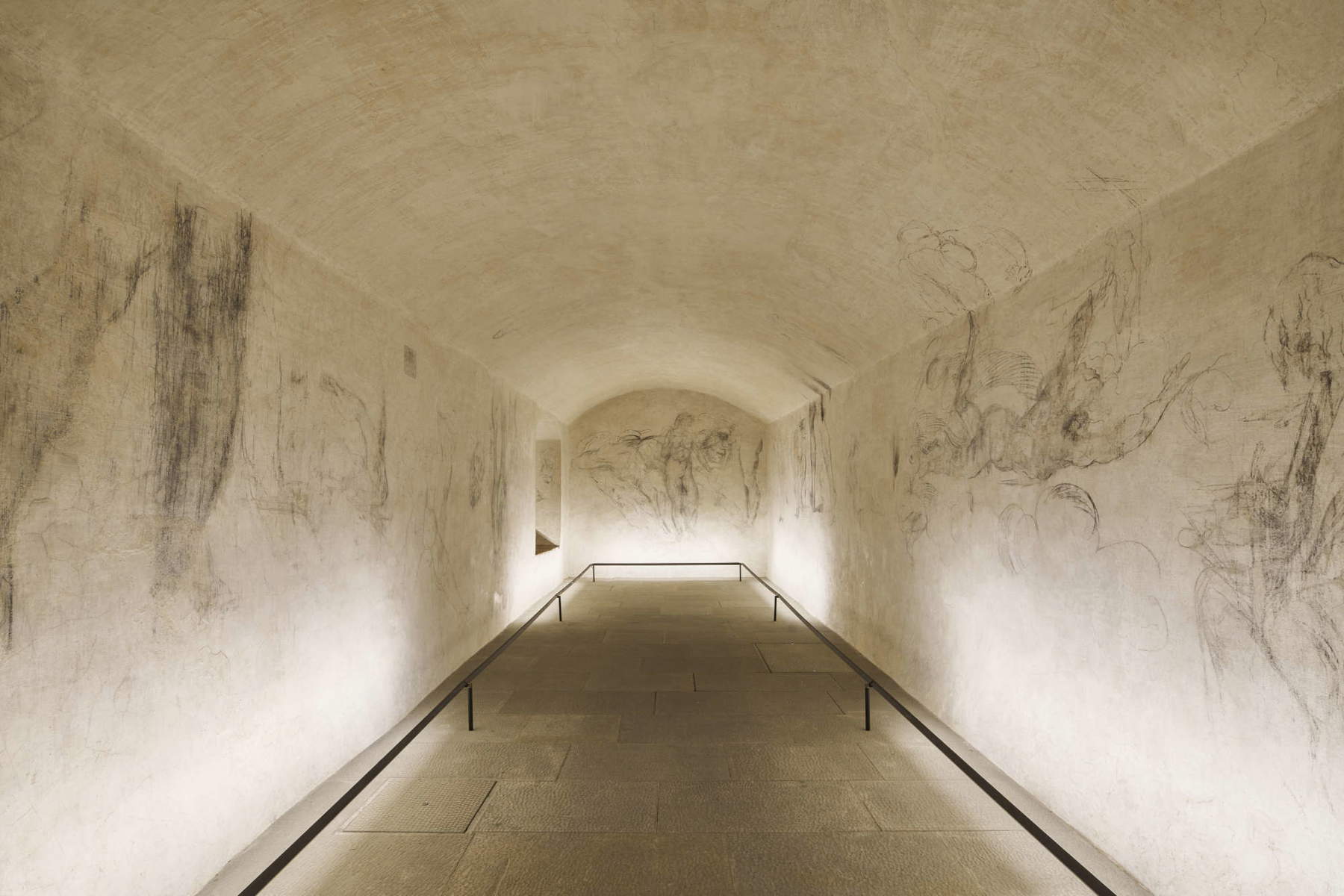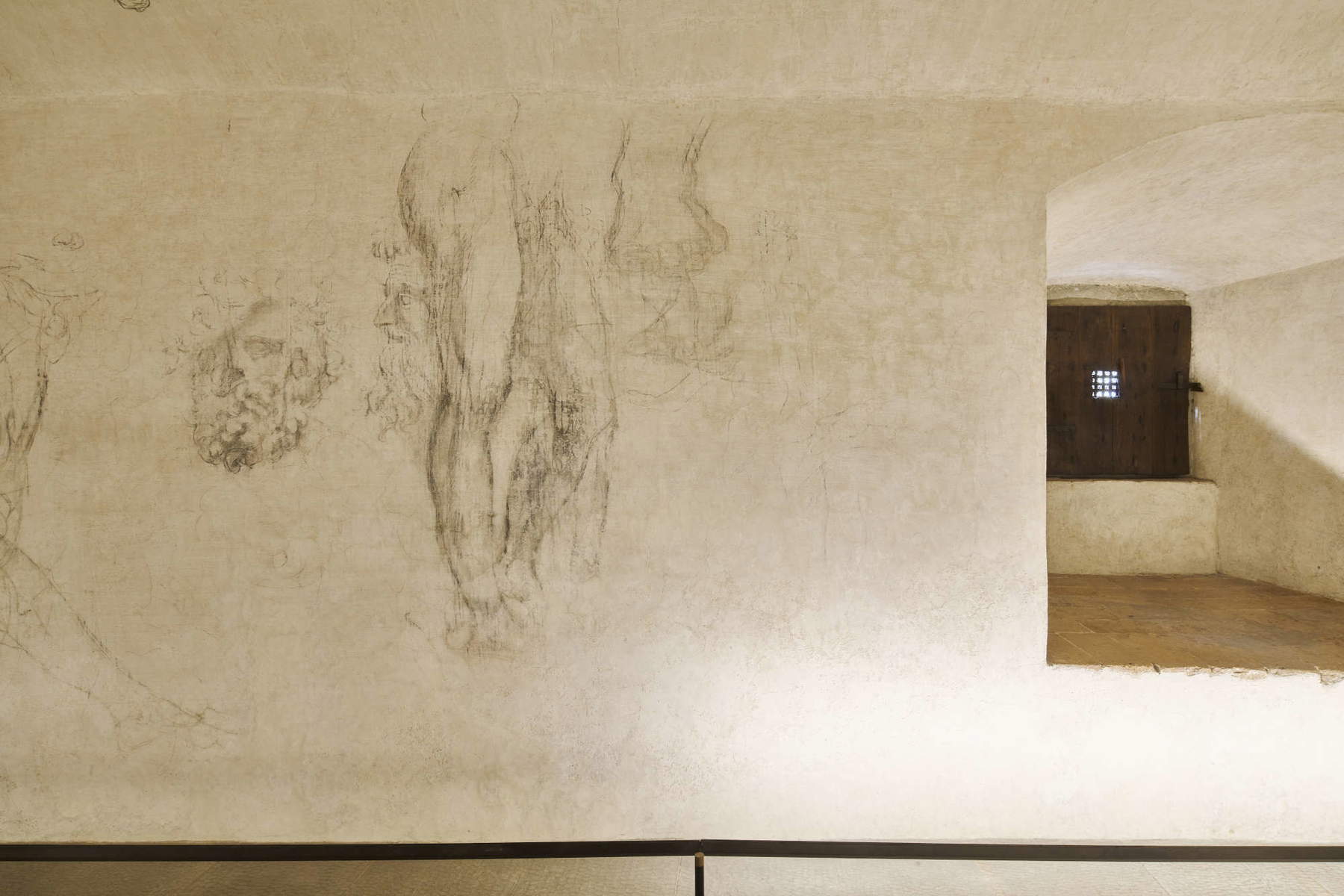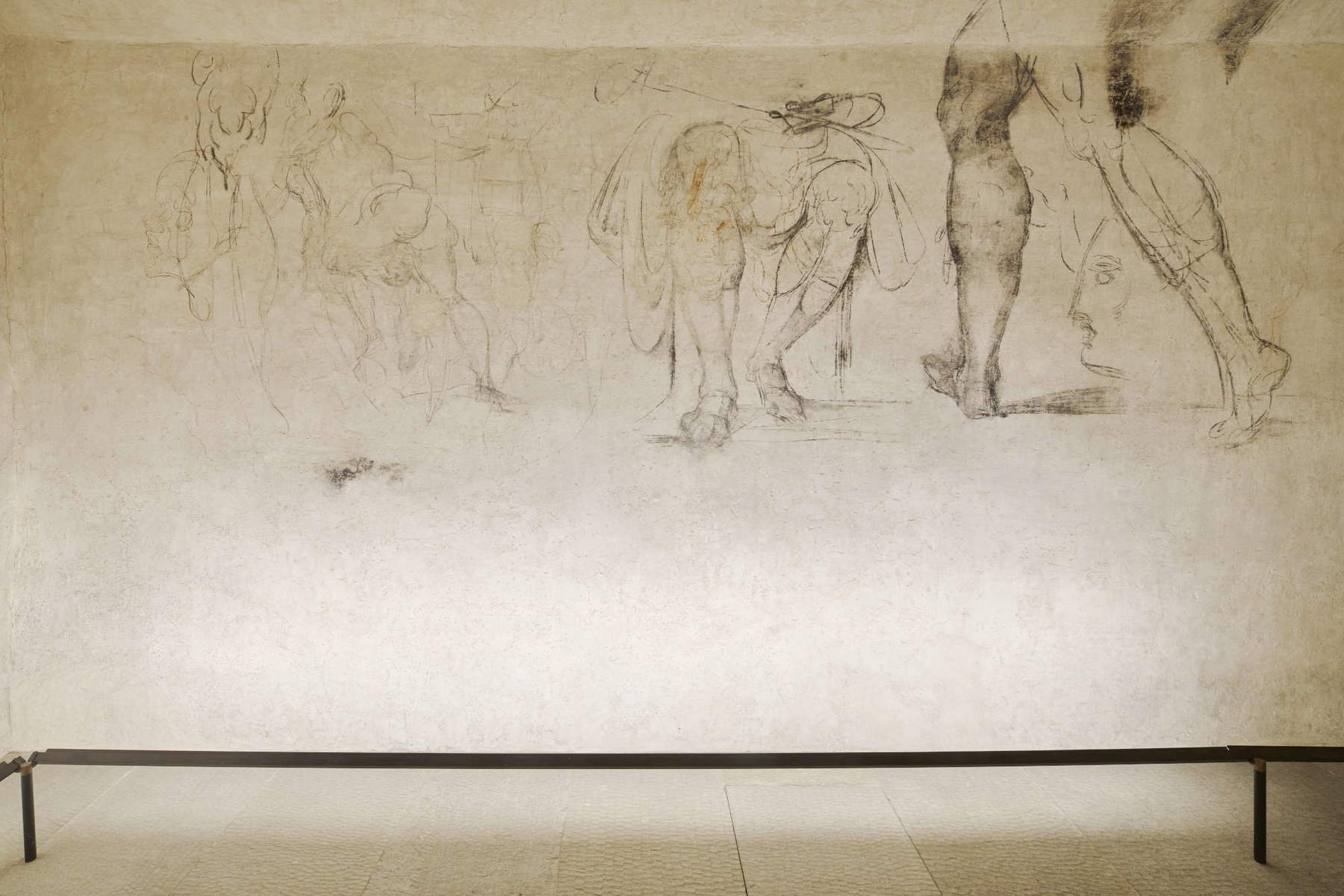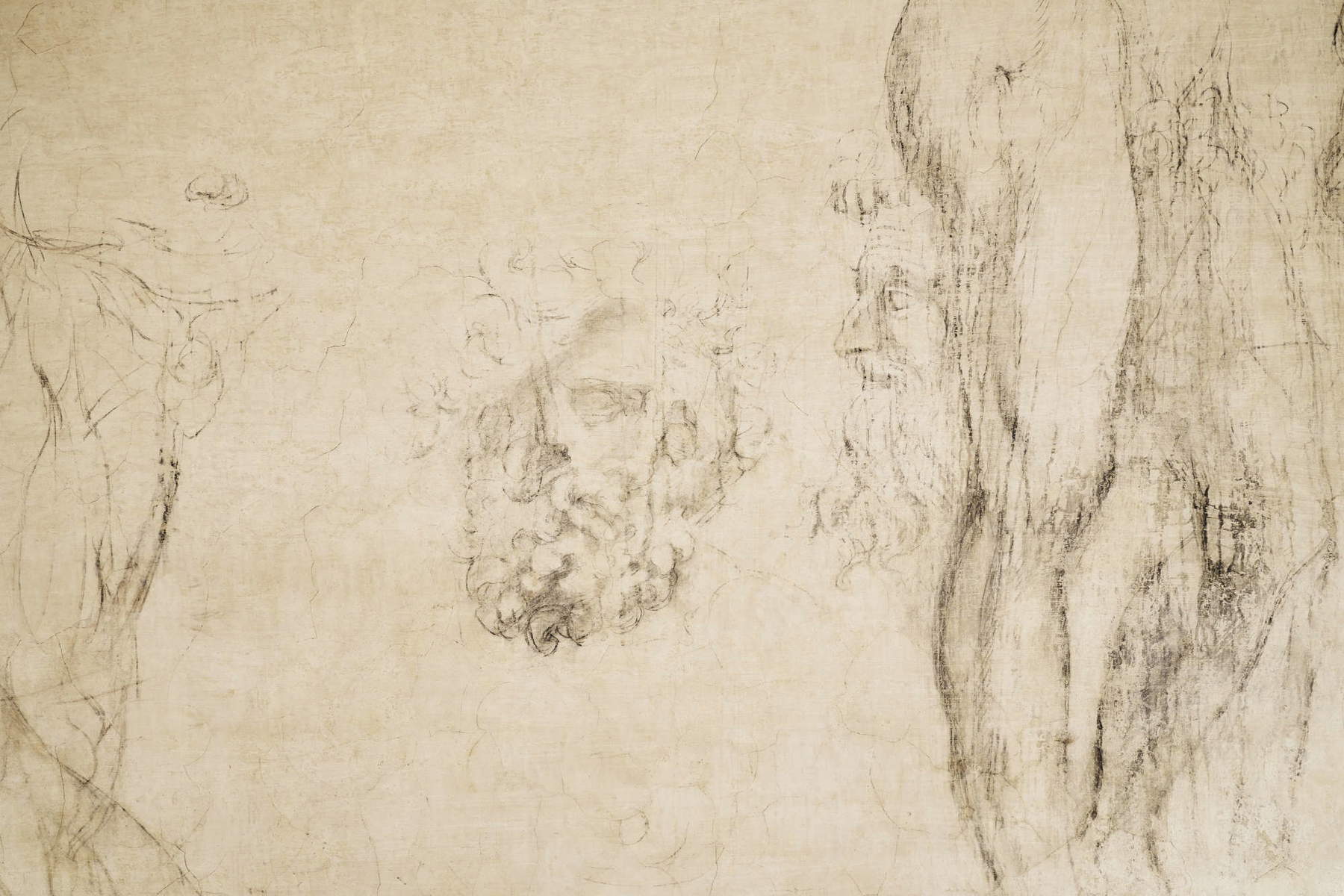In Florence, almost fifty years after it was found (that was 1975), the so-called "secret room of Michelangelo," a small room containing a series of drawings attributed to the great Michelangelo Buonarroti, accessed from the New Sacristy inside the Medici Chapel Museum, will open to the public on Nov. 15, 2023. The opening will be on a trial basis and reservations open until March 30, 2024, on a precautionary basis.
The announcement of the opening of this space was made on Sept. 26, 2023, by the director general of Museums of the Ministry of Culture Massimo Osanna during the press conference for the presentation of the New Exit of the Museum of the Medici Chapels, an integral part of the state group of Bargello Museums directed by Paola D’Agostino.
This room was discovered in November 1975, when Paolo Dal Poggetto, then director of the Museo delle Cappelle Medicee, commissioned restorer Sabino Giovannoni to carry out cleaning tests in a narrow corridor below theapse of the New Sacristy, during a preliminary survey in search of a suitable space for the construction of a new museum exit.



The small room, 10 meters long by 3 meters wide, 2.50 meters high at the apex of the vault, had been used as a charcoal storage room until 1955 and then unused, remaining closed and forgotten for decades, under a trapdoor completely covered by stacked cabinets, furniture and furnishings. It was here, during essays on the walls, that the restorer came across, under two layers of plaster, a series of figure wall drawings, traced with charred wood sticks and sanguine, of various sizes, in many cases overlapping, which dal Poggetto attributed mostly to Michelangelo. The then director speculated that the artist had taken refuge in the small room in 1530, when the Prior of San Lorenzo, Giovan Battista Figiovanni, hid him from the vengeance of Pope Clement VII, who was enraged because the artist (during the period when the Medici were driven out of the city) had served as a supervisor of the fortifications for the brief period of republican rule (1527-1530). Having obtained the family’s pardon, after about two months (which, according to reconstruction, should be between the end of June and the end of October 1530) Michelangelo finally returned free and resumed his Florentine assignments again, until he finally left the city for Rome in 1534. The drawings, which are still being studied by critics, were, according to Dal Poggetto’s thesis, made during the artist’s period of “self-reclosure,” who allegedly used the walls of the small room to “sketch out” some of his projects including works for the New Sacristy, such as the legs of Giuliano de’ Medici, duke of Nemours, quotations from antiquity, such as the head of the Laocoon, and projects referable to other sculptures and paintings.
The Secret Room had never before been accessible to the public in a regulated manner, and its opening will also be possible thanks to the monitoring that will be conducted in the coming months, in agreement with the Opificio delle Pietre Dure. Visits starting November 15 will be for limited groups of a maximum of four people at a time, in order to protect the drawings and maintain adequate conservation conditions, which are essential to safeguard the precious artifacts. The limited number of attendance by time slots is due to the need to intersperse the period of exposure to LED light with extended periods of darkness. In 2018, thanks to the collaboration of the Ministry of Culture with Lottomatica, master Mario Nanni, assisted by architect Maria Cristina Valenti, at that time in force at the Bargello Museums, oversaw the new LED lighting of the Secret Room as well.
“The completion of the work on the New Exit and the adaptation of the Medici Chapel Museum to safety regulations will make it possible to open Michelangelo’s Secret Room,” says Massimo Osanna, “a place of extraordinary fascination, but very delicate because of the location of the narrow room in the museum itinerary and the protection of the charcoal drawings on the walls.”
“It has been a long constant and patient work that has involved various professionals, and I would like to thank all the staff of the Bargello Museums who have worked with me in recent years for this goal,” says Paola D’Agostino, director of the Bargello Museums. “Among them I owe special thanks to Francesca de Luca, art historian and head of the Medici Chapels and Casa Martelli, and to Benedetta Cantini, restoration officer at the Bargello Museums, for their careful care of this extraordinary environment. My profound gratitude goes, to my colleagues at the Opificio delle Pietre Dure who share with expertise and passion so many projects of restoration, diagnostics, monitoring and research on some of the masterpieces of the Bargello Museums.”



“This very small room is truly unique in its exceptional evocative potential. Its walls seem to barely contain numerous figure sketches, most of them monumental in format, traced by signs that attest to great clarity of design,” explains Francesca de Luca, curator of the Museo delle Cappelle Medicee. “These are accompanied by studies, variously accurate or sketchy, of anatomical details, faces, and unusual poses. Not in all of the drawings is perceptible the same sustained qualitative tension of Michelangelo’s graphics, who, according to the reconstruction of Paolo dal Poggetto, discoverer of queta stanza in 1975, might have practiced here in 1530 during his absconding to save himself from the wrath of Pope Clement VII Medici due to his activity as head of fortifications to the republican government, which had expelled the family in 1527. However, this place allows today’s visitors the unique experience of being able to come into direct contact not only with the master’s creative process, but also with the perception of the formation of his myth as a divine artist, who was taken as a model by his contemporary colleagues and by the young members of the Academy of the Arts of Drawing, of which Michelangelo was appointed ”Father and Master,“ which established its headquarters in the Sagrestia in 1563.”
The secret room will be accessible by reservation only, to a maximum of four people per accompanied group, up to a limit of 100 people per week. It will be open on Mondays (at 3 p.m., 4:30 p.m. and 6 p.m.), Wednesdays (at 9 a.m., 10:30 a.m., 12 noon, 1:30 p.m., 3 p.m., 4:30 p.m., 6 p.m.), Thursdays (at 9 a.m:00, 10:30, 12:00, 13:30, 15:00), Fridays (at 15:00, 16:30, and 18:00), and Saturdays (at 9:00, 10:30, 12:00, 13:30, 15:00, 16:30, 18:00). The maximum stay inside the room will be 15 minutes, accompanied by the Museum’s security staff. Since access to the room requires descending a narrow and cramped staircase, the room is not accessible to the disabled and, for safety reasons, to children under the age of 10.
The entrance fee will cost 20.00 euros per person (2.00 euros the reduced ones; free for children under 18) to which will be added the cost of the compulsory reservation (3 euros) and the price of the entrance ticket to the Medici Chapels Museum (10 euros full, 3 euros reduced until December 15, 2023). A total of 30.00 euros plus compulsory reservation for full tickets and 5 euros plus 3 euros compulsory reservation for reduced tickets. Information bargellomusei.beniculturali.it. Reservations: operalaboratori.com - 055. 294883
 |
| Florence, Michelangelo's Secret Room opens to the public after 50 years |
Warning: the translation into English of the original Italian article was created using automatic tools. We undertake to review all articles, but we do not guarantee the total absence of inaccuracies in the translation due to the program. You can find the original by clicking on the ITA button. If you find any mistake,please contact us.